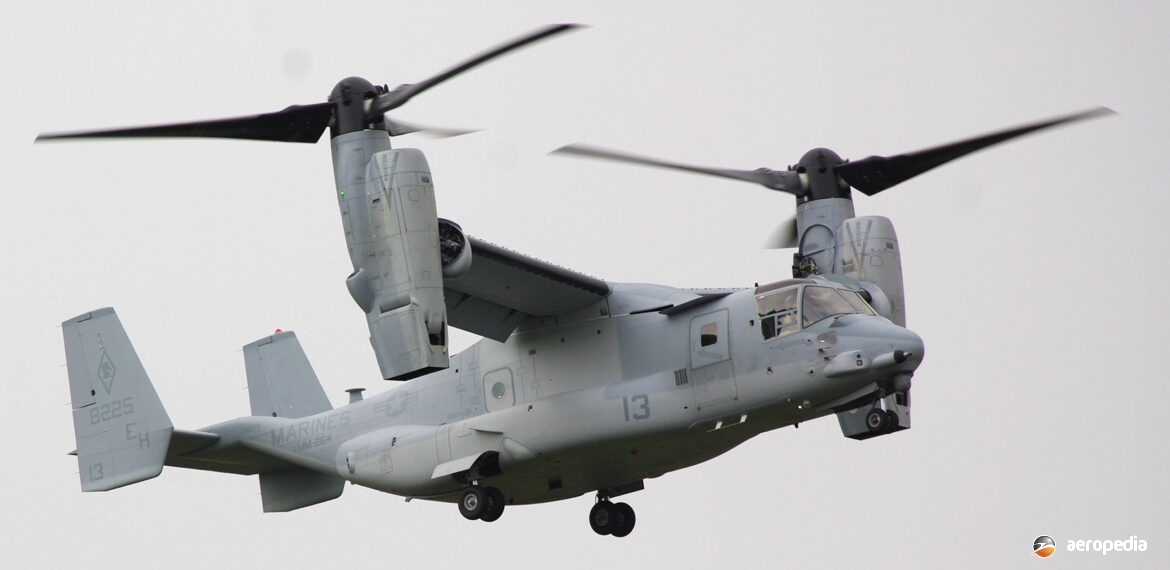Photograph:
Bell-Boeing MV-22B Osprey 8225 at the Farnborough Airshow in the United Kingdom in 2012 (David C Eyre)
Country of origin:
United States of America
Description:
Military tilt-rotor assault aircraft
Power Plant:
Two 4,586 kw (6,150 shp) Allison T406-AD-400 turboshafts
Specifications:
- Rotor diameter each: 11.58 m (28 ft)
- Wing span less nacelles: 14.02 m (46 ft)
- Overall width, rotors turning: 25.78 m (84 ft 7 in)
- Fuselage length: 19.09 m (62 ft 7½ in)
- Overall height: 5.38 m (17 ft 8 in)
- Rotor disc area: 105.4 m² each (1,134 sq ft)
- Max speed in aeroplane mode at sea level: 556 km/h (345 mph)
- Cruising speed in aeroplane mode at sea level: 509 km/h (316 mph)
- Cruising speed in helicopter mode at sea level: 185 km/h (115 mph)
- Max forward speed with slung load: 370 km/h (230 mph)
- Service ceiling: 7,925 m (26,000 ft)
- Take-off run at 24,947 kg (55,000 lb): 152 m (500 ft)
- Range with 5,443 kg (12,000 lb) payload with vertical take-off: 2,224 km (1,382 miles)
- Range with short take-off with 9,072 kg (20,000 lb) payload: 3,336 km (2,073 miles)
- Max range with no payload: 3,892 km (2,418 miles)
- Empty weight: 13,993 lb (30,850 lb)
- Max fuel weight: 6,215 kg (13,700 b)
- Max internal payload: 9,072 kg (20,000 lb)
- Max vertical take-off weight: 21,545 kg (47,500 lb)
- Max short take-off weight: 24,947 kg (55,000 lb)
- Max take-off weight with ferry fuel: 27,442 kg (60,500 lb)
History:
In the 1970s the North American Space Administration (NASA) was working with Bell and Boeing-Vertol to investigate the tilt-rotor concept for an assault vehicle for the US Army. The result was a twin-engine machine which first flew in 1977, with two prototypes being constructed. The type made its first public appearance at the 1981 Paris Air Show in France. Described as the XV-15, this machine demonstrated the concept with some success, being able to achieve speeds in excess of 555 km/h (345 mph). Testing continued for some years until one aircraft experienced a mechanical failure and crashed in 1992.
Development continued for some years and the type entered service with the US military in 2007. It has seen service in Iraq, Afghanistan and Libya, being operated by the US Marine Corps and the US Air Force. A variant known as the BA-609 was also developed for the civil market, this model being flown for the first time in March 2003.
The machine’s structure was fabricated almost entirely of graphite / epoxy solid-laminates and only about 454 kg (1,000 lb) of metal has been used. The engines were developed from the Allison T56, the T406 driving three-blade propellers turning in opposite directions. The nacelles were tilted by screw-jack actuators and a fail-safe mechanism has been included.
Aircraft for the USAF have been operated by special operations units and, designated in the multi-mission category, are known as the CV-22A, being able to carry 12 troops. A variant known as the HV-22A was intended for combat search and rescue, special warfare and fleet logistics support missions. First operational MV-22 unit was VMM-263 in March 2006 and the type replaced the CH-46E and CH-53D helicopters. At that time it was proposed that the Marine Corps would receive 360 examples and the Air Force Special Operations Command would receive 50.
A number of accidents with the type occurred in 2000 and this brought the machine to the edge of extinction, culminating in the aircraft being re-designed to some extent. There was also some restructuring of the program following a history of late deliveries and this brought some operational maturity to the aircraft in terms of delivery and quality, with production getting back on schedule with low-rate production resuming in 2002. On 29 May 2002 flight testing operations resumed at Patuxent River in Maryland, some changes being made to the design.
In the mid-1980s the MV-22 was considered as a contender for the Australian Defence Force assault vehicle requirement but was too expensive for the Australian military.
Examples of the Osprey have visited Australia on board American Navy warships during exercises with Australian, New Zealand and other military forces. In August 2017 during exercise Talisman Sabre an MV-22 Osprey (serial 168634) from US Marine Medium Tiltrotor Squadron 268 was lost when it crashed whilst landing on board the ‘USS Green Bay’ in Shoalwater Bay near Rockhampton, QLD. Carrying 26 personnel at the time, 23 were recovered but three were lost. A search and rescue operation was put in train by US Marine vessels, including the 31st Marine Expeditionary Unit and the ‘USS Bonhomme Richard’ Expeditionary Strike Group. Later attempts were made to recover the airframe from the ocean.
During another exercise Talisman Sabre the MV-22 Ospreys operated with one of Australia’s new assault vessels, ‘HMAS Canberra’ , ‘to increase capability between American and Australian military aircraft’ and landings were made on the Australian warship. Other landings had previously been made on to ‘HMAS Canberra’ by Ospreys during exercises off Hawaii. During these operations between 10 and 14 Ospreys were usually attached to the US Navy vessel during exercises.
In recent years American Marines have been based in the Northern Territory to carry out exercises with a range of countries in our region, these including Japan, New Zealand, China, Indonesia, Malaysia, The Philippines, Singapore and some Pacific Island countries. The Marines rotate to Australia and usually around 1,250 are based in Australia with air combat elements which include four MV-22 Ospreys, five AH-1W SuperCobras, and four Bell UH-1Y Venom utility helicopters. They are part of a six-month rotation of US Marines and conduct about ten major exercises, these including Talisman Sabre, Southern Jackaroo and Exercise Kowari.

